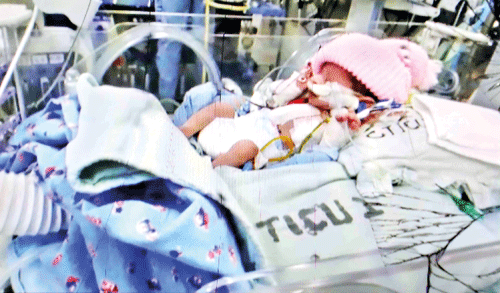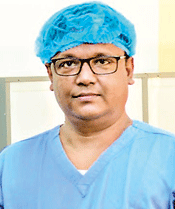A little heart beats against all odds

The baby who had a ‘rebirth’
It was touch-and-go. The distraught parents watched terrified wondering whether their newborn twin son still had life in him for his lips were a blackish-blue and he was not moving.
The 14-day baby was being transferred from a private hospital to the premier Lady Ridgeway Hospital (LRH) for Children, Colombo, at 5 a.m. on April 26.
It was to be an emergency and risky operation on the tiny heart of a baby weighing just around 1.5kg – most probably a first such surgery on a premature baby with such a low weight and multi-organ dysfunction in Sri Lanka.
The surgery was to correct an obstructed Total Anomalous Pulmonary Venous Drainage or Connection (TAPVD) by skilled and caring Consultant Cardiothoracic Surgeon Dr. M.S. Mugunthan.
Giving a quick look at how a normal heart works, Dr. Mugunthan says that a heart has four chambers. Two atria (right and left) and two ventricles (right and left). Usually the oxygen-poor blood from across a person’s body comes to the right atrium and flows through to the right ventricle. From there the pulmonary arteries take it to the lungs.
When the lungs turn it into oxygen-rich blood, it is brought back to the left atrium by the pulmonary veins and then goes through to the left ventricle, from where it is distributed to the body.
“However, in this baby who had TAPVD, the four pulmonary veins were abnormally connected to the Inferior Vena Cava, the largest vein, instead of the left atrium. This allowed the oxygen-rich blood to enter the right side and not the left side of the heart and flow through an atrial septal defect (ASD) or hole in the heart to the left atrium,” says Dr. Mugunthan.
 The abnormality caused a mix of oxygen-rich and oxygen-poor blood which led to low oxygen saturation in the blood resulting in organ dysfunction. The narrowing and obstruction of the pulmonary veins as well as the high blood flow to the lungs were causing congestion and stiffness of the lungs. This was leading to lung and cardiac failure and also impacting adversely on all other organs including the liver and kidneys.
The abnormality caused a mix of oxygen-rich and oxygen-poor blood which led to low oxygen saturation in the blood resulting in organ dysfunction. The narrowing and obstruction of the pulmonary veins as well as the high blood flow to the lungs were causing congestion and stiffness of the lungs. This was leading to lung and cardiac failure and also impacting adversely on all other organs including the liver and kidneys.
It was a “surgical emergency”, reiterates Dr. Mugunthan. The risks were also great with a low-birth weight, prematurity, late presentation and established multi-organ dysfunction.
He explains that before surgery he had to make sure that the baby had no brain issues such as a bleed because he had also got seizures (fits). This necessitated a brain scan as during the heart bypass surgery they had to administer heparin, which prevented blood clotting. If by chance there had been a bleed in the brain, it would worsen with heparin, causing serious consequences.

Dr. M.S. Mugunthan
The parents tell the Sunday Times that it was only 13 days after his birth that they had been told that something was wrong with the baby’s heart, even though he had been in and out of the private hospital’s Neonatal Intensive Care Unit (NICU) and finally even on the ventilator.
What should have been a joyous occasion on April 12, the birth of twins and a nice gender balance too, a girl and a boy, had very soon descended into a nightmare for the couple. The twins had been delivered prematurely (at 35.3 weeks) at 10.53 a.m., through a caesarean-section as the doctors had said that they “could not take a chance” because the boy did not seem to be having a proper blood flow through the umbilical cord.
The twin-girl delivered first, weighed 1.75kg and they endearingly called her “Akka” and the twin-boy who came second weighed 1.65kg (at the time of the heart operation later, the weight had been down to 1.5kg) and they named him “Thambi”. Into incubators the babies went. While the girl was discharged by April 23, the boy was still not out of danger.
A long-delayed echocardiogram had found problems in his heart but a brain scan after he had seizures indicated that there were no blood clots. It was on the night of April 25 that the doctors had a long discussion with the parents about the need for a very dangerous heart operation.
Fortunately, the father knew one of the heart surgeons whose name was mentioned for such a surgery and when he contacted him immediately, he had been advised to rush the little one to the LRH. That’s what the parents did.
Taken to LRH at 5 a.m. on April 26, the parents watched in agony and prayed very hard as Consultant Cardiothoracic Surgeon Dr. Mugunthan went into the Cardiothoracic Operating Theatre (CTOT) at 8 a.m., emerging only at 4 p.m. to tell them that it was successful.
Later moved to the Cardiothoracic ICU (CTICU), there had been nail-biting tension as the LRH staff watched for a movement from the baby. It was on April 28 that Dr. Mugunthan informed them that their baby son had blinked.
The happy parents show me the twins at their home on Tuesday (June 21). Picking Thambi off the bed and planting a kiss on his forehead, the father says: “Dr. Mugunthan gave life back to Thambi. It is like a rebirth.”
No more words are required not only about Sri Lanka’s model state health system where every life, even the tiniest or whether rich or poor, counts, but also the LRH’s quality of service and the skills of the team headed by Dr. Mugunthan, the Cardiologists, the Anaesthetists, the Intensivists, the Medical Officers, the Nurses and the CTOT & CTICU staff.
LRH cares for the country’s children, it is obvious and the parents tell me that they will name their son “Mukunth” as a tribute to the doctor who saved his life.
Searching for an ideal partner? Find your soul mate on Hitad.lk, Sri Lanka's favourite marriage proposals page. With Hitad.lk matrimonial advertisements you have access to thousands of ads from potential suitors who are looking for someone just like you.


